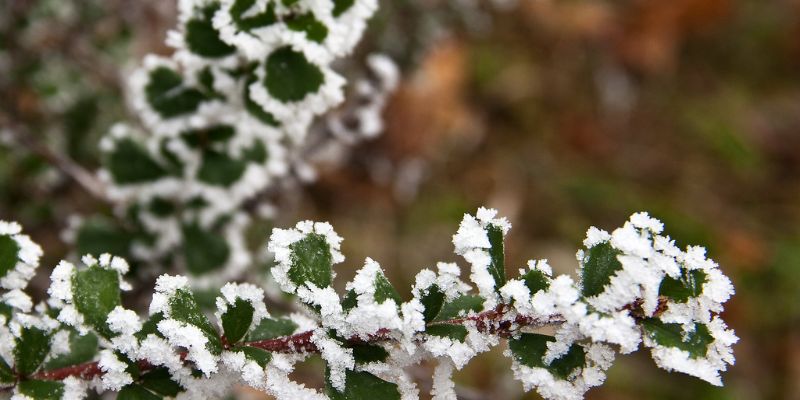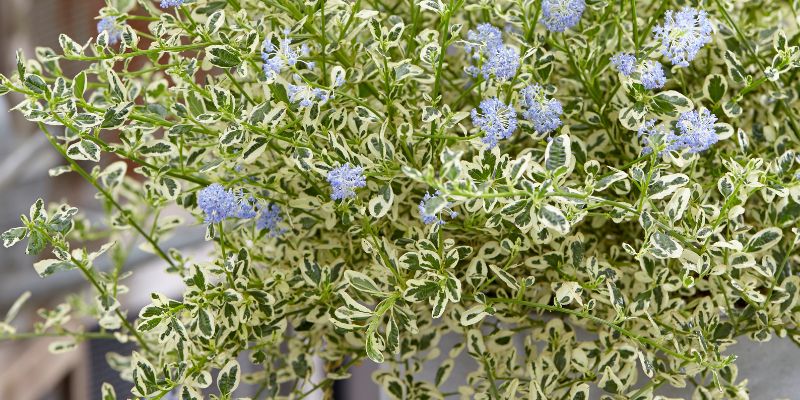The ceanothus or Ceanothus is an appealing bush, one we quickly adopted in our gardens. Its many species and varieties, often native to California, range from tender to moderately hardy, except for deciduous ceanothus, which are more resistant to cold and damp. Discover our methods to protect this floriferous and melliferous bush over winter.

Varieties of varying hardiness
Not all ceanothus have the same tolerance to cold and frost. Evergreen ceanothus are more tender than deciduous ceanothus. Evergreen ceanothus originate from California. Depending on variety, they are rated USDA zones 9a or 8b, with some hardy to zone 8a. That means they tolerate frost down to around -5 to -9°C, and down to -12°C for the hardiest. They tolerate drought and prefer mild or maritime winter climates. Regions with cold, wet winters put them to the test.
In such regions, favour deciduous varieties, which are more resistant to cold and damp. They are classed in zone 7 and withstand down to -15°C when well established as mature specimens. These deciduous ceanothus appreciate soil that remains cool in summer.
The key to controlled hardiness, matching expected values, is to plant the bush in its favourable and recommended conditions. In practice, it is very important to provide all ceanothus with well-drained, fairly light soil. They should also be placed in a sheltered, sunny spot.
Young plants are more sensitive to climatic hazards. After a few years in the ground they become more resilient if planted in good conditions.
With this guidance, assess whether you need to protect your ceanothus over winter according to the variety grown and your region. Keep an eye on weather forecasts, especially if planted less than 4–5 years ago.

When to overwinter your ceanothus?
Act when a cold spell is forecast, before frost, having gathered necessary equipment in advance so you are ready when the time comes. Potted plants suffer before plants in the ground. Common practice is to subtract 2 to 3 degrees from the stated hardiness of a variety to assess its cold tolerance in a pot.
Equipment needed
For a bush planted in the ground, have an organic mulch ready. If the bush has not grown too large and protection is necessary, also have winter fleece or reed screens available. For a potted bush, if you do not intend to bring it indoors, prepare the same equipment.
- Opt for an airy, dry organic mulch, such as straw, prunings, hemp, flax, miscanthus, or wood chips;
- Choose a winter fleece or a zipped winter cover, with grammage chosen according to winter severity in your area (30 g/m2 for a mild winter, 90 g/m2 for an extreme winter).
Protecting a ceanothus planted in the ground from cold
Prepare winter protection for a ceanothus planted in the ground:
- Cover the plant base with a thick 10 cm layer of airy, dry mulch to encourage air and water circulation. The thicker the layer, the better the protection against winter cold. It acts as an insulating blanket for the roots and surrounding soil.
- Wrap the aerial parts with winter fleece, taking care with fragile branches. Tie the fleece at the trunk base, also covering the mulch. Weigh down with stones. Permeable to water and air, this protection lets plants breathe and avoids dehydration risk. It is nevertheless advisable to ventilate from time to time. Alternatively, shelter the plant with a canopy made of reed screens placed all around.
At the end of winter, remove the winter fleece or reed screens. For ceanothus, you can also remove the mulch. If you protected deciduous species that prefer cool soil, leave about 5 cm of mulch to retain soil moisture.
Protecting a potted ceanothus from cold
Ideally, bring ceanothus into shelter in an unheated cold greenhouse or a conservatory. A very bright, unheated room in the house can also work. Place the bush behind a glazed bay or a large window.
If you cannot bring the ceanothus inside, install protections:
- Remove the saucer and place spacers under the pot to insulate the plant from cold and damp.
- Carefully mulch the top of the pot with a very thick layer of organic mulch on the substrate. Install winter fleece as described above.
- If severe cold is forecast, you can also protect the pot by wrapping it with cardboard or bubble wrap.

Winter care for ceanothus
Potted ceanothus
Reduce watering frequency gradually: every 15–20 days in autumn, then monthly in winter, always allowing the substrate to dry between waterings. Check this closely: ceanothus has limited water needs and the substrate dries much more slowly in winter. Do not water deciduous species once they have lost their leaves.
Take your plant outdoors during the day to air it when weather is fine or open the winter fleece to avoid problems caused by confined conditions.
As soon as the risk of severe frosts has passed, return or uncover your potted ceanothus.
In general
Ceanothus foliage may brown with frost, but usually regrows in spring. If cold has damaged your bush, consider severe pruning every 3–4 years. In early April, cut back the branching by one-third to remove desiccated branches and preserve a compact habit. It will not flower in the year of that pruning.































![[protect-cold ceanothe="true"] [protect-cold ceanothe="true"]](https://en.promessedefleurs.eu/blogwp/wp-content/uploads/2022/12/proteger-un-ceanothe-en-hiver.jpg)
Comments